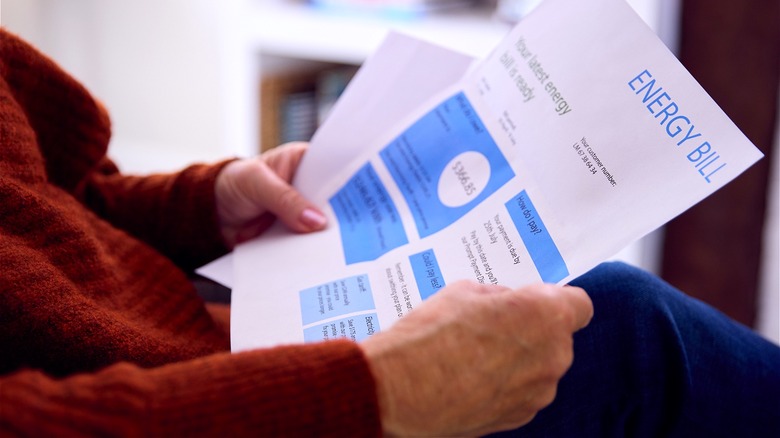These 5 States Have The Highest Electricity Bills In America
If you think you're paying too much for electricity these days, you may be right. According to the U.S. Energy Information Administration, the average cost of electricity in 2022 was 15.04 cents per kilowatt or $135.25 per month. By the end of 2023, that price median rose to 16 cents per kilowatt, per Statista. In comparison, the most-expensive states for electricity in the country in 2024 rose as high as two to three times the national average (again, per Statista), with the most-expensive state (Hawaii) coming in at 43.93 cents per kilowatt.
America's energy bills grew across 37 states between 2022 to 2023. Thinking about ways to reduce your consumption can help (by the way, here are some tips and tricks to save money on your electric bill), although state-run regulatory bodies, the cost of power plants, the distribution of electricity, and even extreme weather impacting the need for heat or cooling are cost factors beyond the consumers' control.
There are things you can control, however. To start, ensure your provider or plan aligns with your needs, especially if you live in a region where energy is deregulated and you always find your bill is high. The condition of your home can make a difference as well, including sealing up any cracks or openings and/or upgrading older appliances with energy-efficient ones, to name a few. While every consumer can benefit from energy savings, this especially applies to those who live in one of the five states where electricity bills are the highest in the U.S.: Massachusetts, Connecticut, Rhode Island, California, and Hawaii.
5. Massachusetts
When it comes to electricity, Massachusetts allows its residents to choose between a default state supplier and outside suppliers, and is one of a few states that does so. Ironically, the belief that more competition would lead to more competitive pricing hasn't been the case. As WBUR explained, the system — which dates back to the 1990s — allows private third-party companies to buy power on behalf of the consumer, which is something the utility would normally do.
The private supplier isn't beholden to state regulated rates, unlike the default provider for the state. When residents who have chosen to go with a third-party supplier receive their bill, the default utility supplier is still listed. Residents pay their bill as usual, then the utility supplier pays the third-party supplier. In 2023, the state's Office of the Attorney General released a report citing $525 million in higher energy bills over a six-year period resulting from competitive electric supply contracts, with low-income residents being twice as likely to be affected. On average, Massachusetts residents pay 29.25 cents per kilowatt, 13.25 cents higher per kilowatt than the national average.
Massachusetts, like other states in New England, also leans on fossil fuels for energy generation, which means international conflicts like the war between Russia and Ukraine significantly impact energy prices in the region. In other words, New England's lack of investment in renewable energy has contributed to residents' higher bills. With this said, Massachusetts in 2008 was one of the first states in the country to address climate change, legislating the Global Warming Solutions Act to create strategies for cleaner and cheaper energy generation in the future.
4. Connecticut
The average resident of Connecticut pays 29.52 cents per kilowatt, 13.52 cents above the national average. Similar to Massachusetts, deregulated non-utility power suppliers have a hand in creating higher costs for residents by forcing customers to carry the cost of electricity they purchase from wholesalers. The Federal Regulatory Commission allows for this arrangement, and retail suppliers also offer fixed- and variable-rate plans that tend to work in their favor at the customer's expense. Spot market prices, meanwhile — an estimated amount of power needed by residents provided by a wholesale market administrator where winning providers are paid the highest bidder price — also tend to negatively affect energy prices for the state. Natural gas, a less expensive form of energy than coal, is more expensive in Connecticut due to the state's heavy reliance on that energy source.
Connecticut's high air-quality standards, which take the impact of coal burning versus the cleaner burning of natural gas into consideration, also contribute to heftier energy bills. And the demand for energy during peak periods, combined with a supply deficit, means power is often imported from outside Connecticut, so the cost of transmission is also baked into the billing price. This situation creates a different problem based on when the regulated power providers are allowed to purchase power from power plants, usually during January and July. Winter and summer are peak periods of power usage for heating and cooling, and as such, the higher costs are passed on to consumers.
3. Rhode Island
Rhode Island takes third on our list of states with the highest electricity bills with an average 30.97 cents per kilowatt. Another New England state, Rhode Island suffers a lot of the same challenges as previously listed Massachusetts and Connecticut — overreliance on imported natural gas that also ties them to market volatility created by embargoes or wars, the closing of cheaper local coal plants to make room for cleaner fuels like natural gas, and a lack of state-sponsored financial incentives for power providers to lean into more sustainable forms of clean energy.
As a countermeasure, the state's Public Utilities Commission has suggested adjusting default utility rates lower, dropping the average bill for a consumer using 500 kilowatts a month by 40% by winter 2024. However, consumers in Rhode Island pay an average $167.94 per month for 500 kilowatts of power, and so the actual amount saved will represent closer to 21%, or $35.47. That number is very close to what independent utility companies look to propose in rate hikes. As reported by the Rhode Island Current in July, Rhode Island Energy proposed raising its rates by 22.8% over summer rates; for consumers in Rhode Island who use 500 kilowatts of power per month, that would equal $31.30.
Prices typically spike during winter as Americans heat their homes and businesses but the war in Ukraine and the cost of wholesale electricity will continue to keep the prices higher this winter than usual.
2. California
The Golden State comes in at No. 2 on this list of states with the highest electricity bills, with a rate of 31.23 cents, which is almost twice the national average. Unlike the first three states on this list, the issues driving California's higher electricity costs have more to do with the adoption of clean energy than reliance on fossil fuels and is another reason why California is one of the most expensive states to live in.
As more Californians adopt off-grid solar power for their homes and/or businesses, it leaves fewer consumers to pay into utilities tied to the grid, raising the cost of doing so. What's more, the higher costs are the catalyst for more people going solar for off-grid power, which leads to even higher costs for everyone else. California boasts 36% of U.S. small-scale solar power production and is second only to Hawaii in watts produced per capita.
1. Hawaii
Hawaii may be one of the most beautiful places on our list, while also having the highest electricity bills in the country. At 43.93 cents per kilowatt, this state's average electricity bill is more than twice the median and almost three times higher.
The U.S. Energy Information Administration reports that fossil fuels account for 60% of electricity production in the country; Hawaii imports most of its fossil fuels, and according to Statista, 78.69% of its electricity production is generated from petroleum. That makes Hawaii one of the most fossil fuel-reliant states for electricity production, while also being the most reliant on outside imports of fossil fuels, which are reasons electricity is so expensive there. Although the average for residences sits at 43.93 cents per kilowatt, as per utility company Hawaiian Electric, that charge can balloon to ~52 cents for Molokai and Lanai, with Oahu offering the cheapest electricity for Hawaii residents at 43.22 cents.





